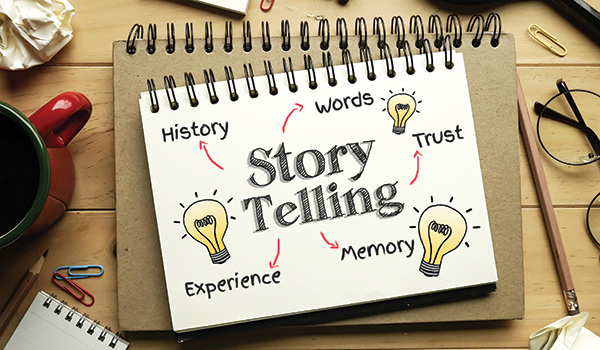
Good storytelling isn’t reserved simply for books and movies and campfires.
“For board members uncomfortable with fundraising, stories are one of the easiest ways to share the power of the work the nonprofit does,” says Phoenix-based Andrea Beaulieu, who offers speaking, story performance, and presentation skills coaching and training. “Story sharing is less intimidating than an aggressive pitch for both the board member and the potential donor.”
Moreover, stories have the power to ignite empathy, often leading to greater philanthropy. And, while not everyone’s brain is geared toward story, everyone can become a storyteller, says Beaulieu. First, an understanding of story and its components is necessary.
Hollywood has long relied on the narrative pattern of The Hero’s Journey for its storytelling. In the case of nonprofits, the hero (the person, cause or animal served by the nonprofit) experiences a change that launches him into a journey. The hero then encounters further obstacles … until the mentor (the nonprofit) arrives to assist the hero as he moves through his biggest obstacle yet. Resolution occurs when the hero, now transformed with the help of the nonprofit, moves on or continues to grow.
Within nonprofits, this story arc is effectively used with real-life examples of “heroes” positively impacted by the nonprofit. These success stories can be used in formal documents, including cases for support and positioning papers, as well as during one-on-one donor visits, in community presentations, online and through social media. “A lot of nonprofits forget the importance of the end user’s story, but it is the emotional connector, not ‘We’ve been around 78 years, serve 33,000 people and raised $34 million,” says Russ Haan, creative director for Phoenix-based After Hours Creative.
Another story — the personal story — is a key tool for board members. “Talk about why you care, personally,” says Beaulieu of visits with donors. “Go out and watch and observe what your nonprofit does so that you have your own personal experience of how it fulfills the organization’s mission. Craft your own story.” Also, ask if all board members can share their personal “why” — Why do I care about this organization?
Beaulieu offers additional storytelling tips for nonprofit boards:
- Apply “The Hero’s Journey” to storytelling. “Once upon a time” isn’t always the best place to start a narrative. Some backstory — showing life is normal for the hero and introducing the activating event that changes his life (not a whole life story) — helps garner attention and empathy.
- Ensure the story reflects the nonprofit’s mission and connects to the donor’s shared values and needs. “All stories should answer this simple question for donors: Why should I care?” agrees Haan.
- Tailor messages, based on audience and type of delivery. Presenting a speech? Understand, first, “Who’s in my room? How do they think? What do they need?” Business executives in that room, for instance, might appreciate statistics upfront and stories that then put those numbers into emotional context. Donors might want story first. Writing a case for support? Consider combined emotional and statistical appeals. Also, understand which stories are appropriate for your audience: success, personal, or even stories of the organization’s origin and founders? Know your audience and adapt accordingly.
- Develop and study the nonprofit’s bank of stories. Encourage staff and board members to sit down together to brainstorm, “What are our key message statements? What stories have we experienced personally — or heard of throughout the organization — that support them?” Begin to build that story bank and simultaneously study existing annual report and blog stories that illustrate community impact. Use these stories.
- Share donor stories during asks. Introduce the story of a like-minded, successful donor when sitting down with a prospect. Talk about how she works with the organization, the impact she was able to make with her gift, her personal reasons for giving.
The truth is that stories sell. They sell products and services, and they sell donors on the importance of a cause. “It’s imperative nonprofit leadership invest in storytelling as a part of its fundraising process,” says Beaulieu. “There is such a richness to the experience when board members and staff share stories of why they care. It ultimately results in better fundraising, but it also brings so much bonding and, often, a renewal of their commitment.”
Fundraising Communiqués: Name Doesn’t Matter
“Case for support,” “investment prospectus,” “positioning paper,” “concept paper” … The nonprofit world has its share of communiqué nomenclature — which can be confusing. It doesn’t have to be, says Haan. “Call these vehicles what you want, but they’re all about making your case: Why care about us?”
Whether five pages, 10, or 25, these communication pieces provide focus and should motivate, excite and inform multiple constituents: potential donors, management teams, volunteers and those being served. “Keep them high-level and make an emotional connection,” says Haan. “Sure, you need to answer questions about a fundraising campaign’s process, flow, timing and budget; but in your storytelling, that’s step two or three.”
Recommended Reading: Seeing Through a Donor’s Eyes: How to Make a Persuasive Case for Everything from Your Annual Drive to Your Planned Giving Program to Your Capital Campaign, by Tom Ahern
“Tell the Story, as if Your Life Depends on It,” by Susan Carey Dempsey, onPhilanthropy.com
Jan Halpin and Julie Iacobelli are principals with The Phoenix Philanthropy Group, an Arizona-based international consulting firm serving nonprofit organizations as well as institutional and individual philanthropists.
















